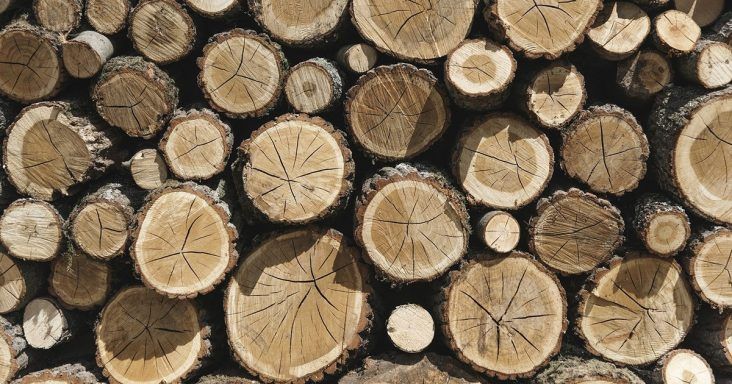Arkansas timber industry facing long-term perils from COVID-19
by May 17, 2020 5:08 pm 2,621 views

For thousands of years, Arkansas’ deep forests were difficult obstacles for Native Americans and later European travelers who tried to traverse the rugged terrain. A few built homesteads and a few woods were cleared to make way for small farms.
Two factors came together after the Civil War that transformed Arkansas into one of the top timber states in the country. Railroads expanded lines in the Natural State, and mechanized sawmills made clearing timber more easy.
One of the state’s top manufacturing sectors, one that has been in place for more than 150 years, has been imperiled by the worldwide pandemic and the ramifications could be long-lasting.
Fewer housing starts, and fewer tree plantings because of migrant labor restrictions are two ways the COVID-19 pandemic slowed economy may affect the Arkansas timber industry, Matthew Pelkki, economist for the University of Arkansas System Division of Agriculture, said.
Pelkki, based at the University of Arkansas at Monticello, is the George H. Clippert endowed chair of forest economics and part of the Arkansas Forest Resources Center.
Forestry is one of the state’s top commodities in terms of cash farm receipts valued at $405 million. Arkansas is the third most timber-dependent economy in the nation.
“The effects will be delayed for the forest products industries,” Pelkki said. “And since demand for wood is derived from manufactured products, the recovery will be slower, particularly for landowners who will likely see very weak stumpage markets in 2021 and 2022.”
The forest products industry is heavily integrated with the larger economy through housing, manufacturing, and consumer goods, Pelkki said.
Housing starts will likely drop, slowing lumber demand and production in the second half of 2020 and first three quarters of 2021. Tree planting and other silvicultural operations will be severely curtailed as immigrant workers with H2B visas are restricted in number and those that are available will be working in food production.
The past several decades have been a turbulent time in the timber industry, especially in Arkansas. During the mid-1990s, the sector was one of the largest in the state. One in six manufacturing jobs in the state — about 43,000 — were in the wood harvesting and processing industry in Arkansas. It had an annual payroll of $1.2 billion and it supported 2,500 different companies, according to the Encyclopedia of Arkansas.
Consumer trends changed greatly heading into the 2000s. Mail use and newspapers declined, causing jobs to shed throughout the decade and it culminated with the Great Recession starting in 2008. The recession devastated the housing and building markets.
As the economy improved in the years after, the Arkansas timber industry began to rebound. In 2016, a Chinese company proposed to open Sun Paper, a $1.5 billion paper mill in Clark County. The mill would have created hundreds of direct and indirect jobs.
The Arkansas Forestry Commission estimated that from 2011 to 2015 Arkansas grew about 25 million tons of pine timber, the wood that Sun Paper needed. About 16.1 million tons of pine timber was harvested, leaving 8.9 million tons statewide. The company hoped to use about 4 million tons per year.
However, the deal to build the plant was terminated in March. The company cited the ongoing trade war between China and the United States and the COVID-19 pandemic as the reasons for the withdrawal.
Pelkki isn’t looking for any quick economic rebounds from this current economic crisis.
“A likely national and global recession will last at least through 2020 and may last until the third quarter of 2021 which will affect demand for consumer goods and manufacturing of high-value products so consumption of pallets and ties will decline,” he said, adding that “global trade in wood products will likewise be curtailed until at least mid-2021, with the most severe declines in the second and third quarters of 2020 lasting through the first quarter of 2021.”
What follows is “possibly a slow recovery that could take as long as two years,” Pelkki said, but the outlook wasn’t all gloom and doom.
“Home remodeling may actually rise in portions of 2020 and 2021 when stay-at-home orders are relaxed, thus helping ease the decline in softwood and hardwood consumption,” he said.
Then there’s one of the pandemic’s most infamous ripples, the mass panic-buying of toilet paper, paper towels and other household paper goods. Pelkki said that pulp demand should be mixed, “with sanitary paper markets being exceptionally strong.” However, finished paper, containers, and packaging markets looked markedly weaker than in 2019.
“U.S. fiscal policy will likely be to maintain extremely low-interest rates to speed the recovery. This will greatly benefit the forest products industry as well,” he said. “In the very long-term, the additional $2-3 trillion of debt that all Americans have taken on could influence economic growth in the future for decades to come.”
